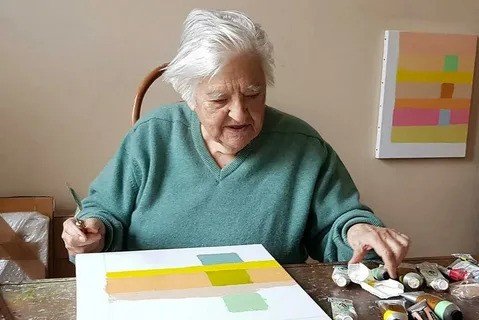Introduction
Etel Adnan, a name synonymous with creativity, intellect, and resilience, has left an indelible mark on the worlds of art and literature. A Lebanese-American poet, essayist, and visual artist, Adnan’s work transcends cultural boundaries, blending her rich heritage with a modernist aesthetic that speaks to universal themes of identity, memory, and the human experience. This article delves into the life, art, and literary contributions of Etel Adnan, exploring how her multifaceted career has influenced both contemporary art and literature.
Early Life and Education
A Multicultural Background
Born in 1925 in Beirut, Lebanon, to a Syrian Muslim father and a Greek Christian mother, Etel Adnan’s upbringing was steeped in cultural diversity. This multicultural environment played a significant role in shaping her worldview and artistic vision. Adnan was fluent in several languages, including Arabic, French, and English, which later became the mediums through which she expressed her artistic and literary talents.
Academic Pursuits
Adnan’s academic journey took her from Beirut to Paris, where she studied philosophy at the Sorbonne. Her intellectual curiosity and passion for knowledge were evident early on, and she later continued her studies in the United States, earning a master’s degree in philosophy from the University of California, Berkeley. Her philosophical background profoundly influenced her work, infusing it with deep introspection and existential themes.
The Literary Contributions of Etel Adnan
Poetry and Prose
Etel Adnan’s literary career began in the 1960s, during a time of political upheaval and social change. Her poetry and prose are characterized by a lyrical intensity and a deep connection to the natural world. Adnan’s writing often reflects her personal experiences, from her memories of Lebanon to her observations of the American landscape. Her work is imbued with a sense of longing and nostalgia, as well as a profound awareness of the transient nature of life.
One of her most notable works is “Sitt Marie Rose” (1978), a novel that explores the complexities of the Lebanese Civil War through the lens of a real-life tragedy. The book, written in French and later translated into several languages, has been hailed as a powerful anti-war statement and a feminist critique of patriarchal society. Adnan’s ability to convey the horrors of war with poetic eloquence has made “Sitt Marie Rose” a seminal work in contemporary literature.
Essays and Philosophical Writings
In addition to her fiction and poetry, Adnan has penned numerous essays that delve into philosophical and political themes. Her essay collection, “In the Heart of the Heart of Another Country” (2005), offers a contemplative exploration of exile, identity, and the sense of belonging. Drawing from her own experiences as a diasporic writer,Etel Adnan examines the emotional and psychological complexities of living between cultures. Her essays are characterized by a profound empathy for the human condition, as well as a sharp critique of colonialism and imperialism.
Etel Adnan as a Visual Artist
The Transition to Painting
While Adnan is perhaps best known for her literary work, her visual art has garnered significant attention in recent years. She began painting in the 1960s, initially as a way to express herself without the constraints of language. Her early paintings were characterized by bold colors and abstract forms, often inspired by the landscapes of California, where she spent much of her life.
Adnan’s approach to painting is deeply intuitive, guided by her emotions and memories rather than strict adherence to artistic conventions. Her works are often small in scale but rich in color and texture, capturing the essence of a moment or a place with remarkable clarity. The simplicity of her compositions belies the depth of feeling and thought that underpins each piece.
Recognition and Exhibitions
Over the years, Adnan’s paintings have been exhibited in galleries and museums around the world, earning her recognition as a significant figure in contemporary art. Her work has been featured in prestigious exhibitions such as the Whitney Biennial in New York and the Documenta in Kassel, Germany. Despite her late entry into the art world, Adnan’s paintings have resonated with audiences, particularly for their vibrant use of color and their meditative quality.
In 2014, at the age of 89, Adnan was awarded the prestigious Ordre des Arts et des Lettres by the French government, recognizing her contributions to both literature and art. This honor solidified her status as a true polymath, whose work transcends disciplinary boundaries.
Thematic Exploration in Etel Adnan’s Work
Nature and Landscape
One of the most consistent themes in Adnan’s work, both literary and visual, is her deep connection to nature. Whether through the lyrical descriptions in her poetry or the vivid landscapes in her paintings, Adnan’s work is suffused with reverence for the natural world. Her writings often evoke the rugged beauty of the Lebanese mountains or the serene expanses of the Californian coast, while her paintings capture the play of light and color across a landscape.
Adnan’s relationship with nature is not merely aesthetic; it is also philosophical. She sees the natural world as a source of solace and inspiration, as well as a reminder of the impermanence of life. Her work reflects a profound awareness of the cycles of birth, growth, decay, and renewal, which she explores through her depictions of changing seasons, weather patterns, and natural phenomena.
Identity and Exile
Another central theme in Adnan’s work is the exploration of identity, particularly in the context of exile and displacement. As a writer and artist who lived between multiple cultures and languages, Adnan’s work often grapples with questions of belonging and alienation. Her experiences as a Lebanese woman living in the West are reflected in her writings, which frequently explore the tensions between East and West, tradition and modernity, and memory and forgetfulness.
In her essays and poetry, Adnan examines the psychological and emotional impact of exile, portraying it as both a burden and a source of creative energy. Her work resonates with anyone who has experienced the dislocation of leaving one’s homeland, as well as the complexities of forging a new identity in a foreign land.
War and Peace
Given the tumultuous history of her native Lebanon, it is no surprise that themes of war and peace figure prominently in Adnan’s work. Her writing often reflects the trauma of war, not only as a personal experience but also as a collective one. In “Sitt Marie Rose,” for example, Adnan delves into the horrors of the Lebanese Civil War, offering a searing indictment of violence and its dehumanizing effects.
At the same time, Adnan’s work is suffused with a longing for peace and reconciliation. Her poetry and essays often express a deep yearning for harmony, both within the individual and in the wider world. This dual focus on war and peace is a testament to Adnan’s belief in the power of art to both bear witness to suffering and to imagine a better future.
Legacy and Influence
A Global Impact
Etel Adnan’s work has had a profound impact on both the literary and art worlds, influencing a new generation of writers and artists. Her ability to seamlessly blend different forms of expression—poetry, prose, painting—has inspired others to explore interdisciplinary approaches to their work. Adnan’s commitment to exploring complex themes such as identity, exile, and the human relationship with nature has also resonated with audiences worldwide, making her a truly global figure.

Recognition and Awards
Throughout her career, Adnan received numerous accolades for her contributions to art and literature. In addition to the Ordre des Arts et des Lettres, she was honored with the Lambda Literary Award, the California Book Award, and the PEN Oakland Josephine Miles Literary Award, among others. These awards reflect the wide-ranging impact of her work and her ability to connect with diverse audiences.
Continuing Relevance
Even after her passing in 2021, Etel Adnan’s work continues to be celebrated and studied. Her writings remain a touchstone for those interested in the intersections of art, literature, and philosophy, while her paintings are increasingly recognized for their contribution to modern art. As new generations discover her work, Adnan’s legacy as a pioneering artist and thinker will undoubtedly endure.
Conclusion
Etel Adnan was a remarkable figure whose work transcended cultural and disciplinary boundaries. Whether through her evocative poetry, her insightful essays, or her vibrant paintings, Adnan explored the complexities of the human experience with grace and intelligence. Her legacy as a poet, philosopher, and artist continues to inspire and challenge, offering new ways of seeing the world and our place within it.
As we reflect on the life and work of Etel Adnan, we are reminded of the power of art and literature to bridge divides, heal wounds, and illuminate the path forward. Her contributions to both fields are a testament to her boundless creativity and her unwavering commitment to exploring the deepest questions of existence.







